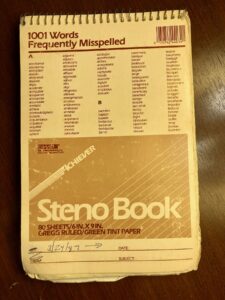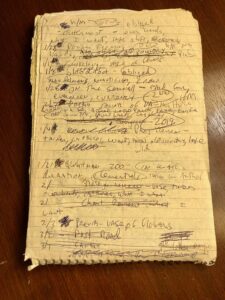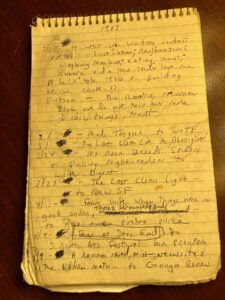The Notebook

“I love my rejection slips. They show me I try.” — Sylvia Plath
3/24/87 is written on the cover of the notebook I used to track submissions for more than thirty years. The first ones recorded in this edge-worn notebook went to the annual contest conducted by West Virginia Writers, an organization that nurtured me when I was first stepping off the solid ground of journalism into fiction and poetry, and to which I’ve returned as a teacher.
When I began sending out work, I made handwritten lists on scrap printer paper. Amazingly, those fragile sheets survived, tucked inside my eventual tracker of choice—the steno notebook. I was a reporter at the time and preferred the larger format over Reporter’s Notebooks too narrow to contain my sprawling letters. (I had tried to copy my father’s neat draftsman’s lettering, but that soon decayed under the pressure of getting it all down.)

This notebook is a distillation of my early writing life. I was green as grass, green as the pages of that Gregg ruled, spiral bound notebook. They say to submit where you want your work to appear, and I followed that maxim with the expected amount of success. I blush to see regular submissions to The New Yorker, where I’ve not (yet!) landed, and to The Missouri Review and Poetry and The Georgia Review, where I eventually did.
We don’t know what we don’t know. I’d gone to journalism school, child of a blue collar world where if you went to college (and that was a big “if”) you got your bachelor’s and then a job to start paying back that student loan. I didn’t think about graduate school or major writing programs. So while I worked the crime beat, I sussed out the literary world by reading Writer’s Digest and sundry books by experts, finally making my way into the writing community through WVW and a writing group that developed out of a women’s creativity conference.
Along with voluminous early rejections, there were successes. Poems in small magazines. A chapbook won a competition later that year, three SF short stories landed and a literary one was selected by PEN Syndicated Fiction. A novel, when that meant a brick of manuscript mailed off in a copy paper box, and edits coming back with flags flying at the edge of hand-annotated pages. Neena Gathering came out in 1988, and I thought with that post-apocalyptic Appalachian tale my writing course was set. A second SF novel was submitted and accepted, only to be eaten alive in one of the first publishing mega-mergers. I turned to mainstream fiction, but gradually found my way back to my first love, literary genre writing.
Those early acceptances were enough to keep me going, but there were failures of nerve as well. Handwritten encouragement came from editor extraordinaire Rust Hills and a blue notecard signed by Joyce Carol Oates from The Ontario Review—but after a couple of rejections, I was too timid to try again, thinking they were “just being polite.”


The notebook is quite a mess. Stories that were never sent are marked through or “whited out.” My system, drawn from a reporter’s habit of putting a star beside a juicy quote, was to list the date of submission and add a star to indicate it was active. When the almost inevitable rejection came, I scribbled out the star. Occasional acceptances were circled. I still use this old-school method today, on a new notebook, though there are certainly better ways.
Jennifer Chow, Lefty Award-nominated author of the Sassy Cat Mysteries and the L.A. Night Market Mysteries, uses a different spreadsheet for each work. “I’d put in the dates submitted and the responses—or closed out the entries if they didn’t respond within a certain number of months. For a while, I used QueryTracker (https://querytracker.net/), but they don’t always list every possible publisher/agent.”
“I love the idea of a spreadsheet, but I’ve been submitting since the late ‘90s, so it’s too much to retype,” tweeted novelist Miriam Herin (A Stone for Bread, Absolution). “I list them with the date sent. But I seldom send out many submissions simultaneously.”
Kim Keeline, mystery writer, replied, “My husband studies Edward Stratemeyer, the early 20th century author who invented Nancy Drew and a lot of other series. And he had a Literary Account Book where he listed all his writing (and, amusingly, the birth of his daughters). So…I made an Excel spreadsheet that I named my literary account book. I list each work, the date I submit it, where I submit, when I expect to hear back, and the end result and income (if any).” She uses a stoplight coding system: green for success, red for rejection, yellow for waiting.
“Tracking…it’s a job in itself,” commented Wil Emerson, “but my most successful way had been to keep a calendar and a logging system. On the calendar, I write what I submitted on such and such day. On a larger file, a notebook of sorts, I have each short story and a separate one for novels, all a page to itself. I write what was sent out, who to, number of words and then have a column for A or R… At the end of the year, I cross check each file. So far it’s my best system. I tried online trackers but never seemed to keep updating them or forget to look.”
“I just have a huge draft alphabetical by journal name,” tweeted Appalachian poet V.C. McCabe.
Gayle Nastasi said, “Many years ago, before and during the early days of ‘the Internet,’ I was part of a wonderful writing critique group called The Sandbaggers. We were just a small group of folks who became good friends, and one of our members was a software programmer. He wrote a little program (I think it was initially for DOS but then he ported it to Windows 3.1 … yes, I’m that old) called SAMM. Sandbaggers Automated Manuscript Manager. It was great, and made keeping track of submissions, responses, and more, so easy. Nowadays I just use Excel spreadsheets, like most of the people who’ve responded, but I’m betting I still have a copy of SAMM around here somewhere…probably on a 5.25″ floppy.”
Submittable, Duotrope, and other online systems changed our landscape. Rather than sending out hard copies with SASE, everything became quick and electronic—I was an editor at two literary journals, one during the time of stacked manila envelopes, one during the transition to online. A few journals built their own systems and a few continue to accept mailed submissions.
There is something to be said for a physical manifestation of the persistence needed to be a writer. You keep writing, keep pushing the work out there. A certain amount of randomness becomes evident—this poem is taken immediately, while that one makes the rounds and seems to lose luster until it lands at a top-tier quarterly. Winston Churchill said that “success is stumbling from failure to failure with no loss of enthusiasm.” I believe that’s particularly true for creatives.
When it came time to retire the notebook, I didn’t go to a dazzling new app, I went looking for another steno book. This one does not feature the list of “1001 words frequently misspelled” of the Camp version. Also, the paper is white not green, but the wide Gregg ruling remains, leaving room for crossing-out and adding-in.
I made the final entries at the bottom of the final page in February 2019. It would be a good year, with To the Bones, my fourth novel, coming out that June. The old notebook was tossed in a purple milk crate along with drafts, letters, and clippings, all of it bound for the Regional History Archives at West Virginia University Library.
And I’m using a new notebook, officially starting 2/2019. The first submissions went out to Arkana, Cheat River Review, and The Raleigh Review.
All rejections.


